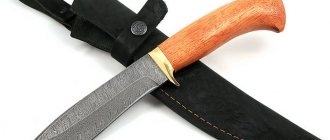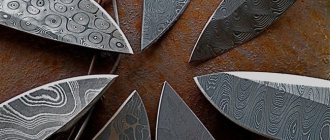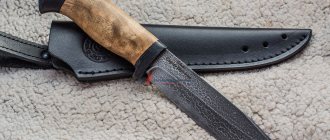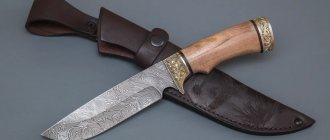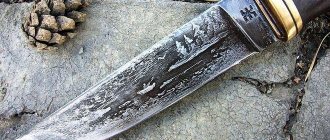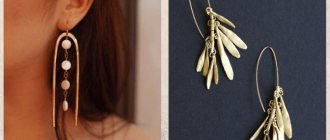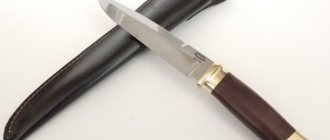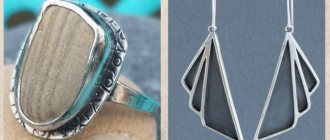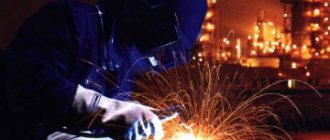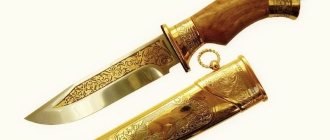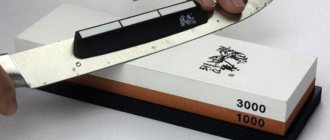If the chemical composition of damask steel or damascus is practically the same, then the technology for forming these steel options differs, which provides a noticeable difference in the structure and their properties. Both materials have the famous pattern that is the hallmark of these steels, and therefore even a non-specialist can recognize them.
Damascus steel.
Characteristics
Many people wonder what Damascus steel is for knives and why it is so popular. Its distinctive feature lies in the manufacturing method - alternating layers. The production process uses one layer with a high carbon content and a second layer with a low carbon content. A high level of carbon gives the product sharpness, while a low level gives it strength. Proper adherence to proportions and sequence of stages makes Damascus cutting objects incredibly sharp, strong and durable. Don't forget about the signature Damascus steel pattern on the knife.
The hardness of the product is determined according to the Rockwell scale. On the blade itself you can see the abbreviation HRC. The higher the number, the stronger and more durable the metal on the product. For example, the hardness of Chinese blades is 40 HRC, and that of samurai blades is 65 HRC. The indicator of high-quality Damascus steel will be at the level of 60-65 HRC.
Knife handle care
Caring for the handle of a knife is no less important than maintaining the blade. Popular wooden and leather handles must be protected from prolonged contact with moisture to avoid deformation, swelling and cracking. If the handle gets wet, it should be dried in a warm and shaded place. If you dry a knife in bright sun or near heating devices, sudden evaporation of moisture and temperature changes can cause cracks, warping, and deformation.
The handle should be serviced along with the blade after each use of the knife and during routine inspection. Special furniture care products and vegetable oils, such as olive, linseed, and clove oils, are suitable for lubricating wood.
Handles made of horn or polymers should be wiped regularly and protected from moisture and direct sunlight.
Kinds
There are 3 main types of Damascus: layered, mosaic and torsion.
The forging process allows the production of metal with a multilayer structure with different compositions. The larger the pattern on the blade, the fewer layers were used during forging. The strength of steel will depend precisely on the number of layers: more layers, higher strength. However, a complex pattern in the form of zigzags or waves will only worsen the blade. A tool with thin and straight lines is a higher quality product with a long service life. To understand how knives are made from Damascus steel, you need to consider its types.
Layered Damascus
The layered type is the most common and easiest to manufacture. This type mainly includes knives. To create them, from 40 to 120 layers of steel are used. The number of layers directly affects the pattern of the blade; in the alloy they are located parallel to the product. This is how the pattern is obtained from equidistant straight lines. The famous Japanese katanas, with their straight pattern at the blade, are also classified as a layered type of Damascus steel.
Mosaic Damascus
The pattern on the mosaic blade is formed on the basis of various types of metal. The manufacturing process uses a press to ensure uniform processing. The patterns consist of diamond profiles that fit tightly together for better welding. After welding, the steel package is cut into small 30 mm plates with a mosaic pattern. These plates are then used to make blades with a special mosaic pattern.
The main “disadvantages” of mosaic damascus are low strength and low cutting properties.
Torsion Damascus
The peculiarity of the torsion bar is the twisted pattern on the knife, which is obtained thanks to rectangular rods. They are heated and then pulled into a bar, twisting around the axis of a steel package. The output is a pattern with helical lines that are inclined around the axis of the product. Torsion Damascus is the most difficult type to manufacture, since during the forging process the steel rods can be twisted, causing them to deform and burst.
You need to make a choice on this or that type of Damascus knife, taking into account many factors, but this is a matter of taste.
Differences between damask steel and Damascus steel
What is damask steel and how do different types of steel generally differ? Patterned metals were called differently at different times and by different peoples.
Various names for this metal were used:
- wootz;
- damask steel;
- Damascus steel;
- multi-day iron.
Let's consider two types - damask steel and Damascus steel.
The name damask steel has an ancient origin and comes from the Indo-Iranian word “pulad”, which means (refined iron). Hunting knives made of damask steel are distinguished by good cutting properties and excellent strength. And blades made from damask steel are quite expensive, and the choice is not very large.
Damask steel is a very durable alloy with a high coefficient of inflexibility and sharpness retention. This is a collective term that does not have a fixed manufacturing technology or appearance.
A hunting knife made of damask steel has various types of patterns on the blade, and it is superior to hunting knives made of Damascus steel in all respects:
- strength;
- no corrosion.
Bulat is steel that has been melted and cooled in a crucible in a special way, and its production is more expensive than Damascus.
Another name for damask comes from the word damask (wavy). Damascus steel is inferior to damask steel in certain indicators, but takes precedence with its variety of blades and relative cheapness.
It is obtained as a result of a complex technological process performed by hand. According to technology, there are always more hard steels than soft ones. The steel obtained in this way has about 400 layers, which gives it special strength, excellent cutting ability and unique beauty. Unique - in the literal sense of the word, because the pattern never repeats, just like people's fingerprints. Damascus steel is a separate grade of damask steel, differing from it in the beauty of the blade and its strength.
Damascus steel is prepared from plates through a forge welding process.
Damascus and damask steel mainly differ from each other in manufacturing technology and therefore they differ in appearance and physical properties.
Processing methods and technologies for the production of steel knives
Processing of refined steel
A monolithic block is required for processing. The steel is cleaned of impurities and slag, and carbon is evenly distributed in the workpiece. Hardening produces high-quality knives. The method was popular until the 18th century.
Welding method
Metals with different carbon contents are fused into one whole. The result is flexible and durable blades that absorb the advantages of both types of iron.
Bulat
Divided into two types:
– crucible damask steel (the metal is boiled in a crucible for a long time, then the alloy is cooled and the blade is forged);
– cast damask steel (blades are produced through a long-term melting process of metals with high and low carbon content; usually alloying elements are added to the mixture to improve the mechanical properties of the product).
Care of the scabbard
Knife care should not be one-sided. After cleaning the blade and lubricating the handle, you need to take care of the sheath. The main thing to understand here is that the sheath is a means of transporting a knife, and not a place for storing it. Tannins in the leather negatively affect the steel of the blade, and a wet and dirty knife left in the sheath for a long time can cause swelling and loss of elasticity of the material.
The outer surfaces of the sheath must be regularly cleaned of contaminants and treated with automotive leather conditioner. It is important not to forget to remove lint, grains of sand and other small debris from inside the sheath that may scratch the blade.
Leather easily absorbs stubborn pollutants such as rust. Therefore, if oxide has formed on the knife, you should not allow it to get on the surface of the sheath. It is also important to promptly renew torn seam threads and replace failed rivets.
How to check for quality
The question of how to check a Damascus steel knife is extremely difficult. It is almost impossible to determine “by eye” what kind of steel a product is made of. The only proven way is to test the knife in use.
After working with a carving knife, small nicks should appear on a real Damascus blade. This is due to the fact that one metal retains its hardness, while the soft one is squeezed out.
Shiny areas should also appear on the edge of the blade. This is a feature of the material, and not a sign of dullness of the product.
Damascus knife: product features
Damascus steel has a number of unique characteristics that are unique to this material. Knives made from high-quality Damascus have the highest cutting properties, which are 2-3 times superior to products made from other types of steel. But it should be noted that Damascus knives have one significant drawback. The metal contains carbon steel, so knives can quickly become rusty. Of course, this will not happen if you properly care for your Damascus knife.
Advantages and disadvantages
Damascus knives are popular due to their sharp yet durable blade. The blades cut through bones with ease. Depending on the manufacturing technology used, the blade can be given different properties. For example, the refining method removes slag and impurities from the metal, and carbon is distributed evenly throughout the product. When welding, metals with different levels of carbon are bonded, due to which the finished product combines the beneficial properties of the fused materials.
In addition, each Damascus steel blade has a unique pattern. Therefore, such knives have collectible value and are suitable for gifting.
The uniqueness of the pattern, the complexity of production and the properties of the finished product determine its high price.
Another disadvantage is that due to the carbon composition, the blade is susceptible to corrosion. To make it last longer, it is better to store it in an oily liquid.
Removing rust from a Damascus steel blade
So, we have a knife forged from Damascus steel, covered with slight corrosion and with a deplorable appearance.
Let's bring it back to its former glory. The entire procedure is completed in three simple steps and takes 15 minutes.
Step 1. Place the blade in 70% acetic acid. We actually perform the metal etching procedure. Soak the blade in acid at room temperature for 5-7 minutes.
Step 2. Now use 600 grit sandpaper to carefully sand the blade. In this case, the word “carefully” means that you need to rub sandpaper over the surface of the blade so that the pattern appears evenly. Because if you rub some parts more intensely than others, it will appear as light and dark spots. Sanding will take approximately 5-7 minutes.
Step 3. The blade became like new. Now we need to consolidate the result. To do this, thoroughly wash the remaining vinegar from all the nooks and crannies of the knife. Preferably running water.
and dry the knife so that the remaining water does not spoil all the work
Finally, lubricate the knife. There are possible options here. It is good to lubricate with lard (it is safe if it gets into food), but not with salt - salt can cause corrosion. You can lubricate with medical mineral oil - it is also safe. It is better not to use sunflower oil - it thickens. If you only need to cut envelopes and not food, then sewing machine oil or WD-40 will work well.
That's all. After this simple procedure, the blade became like new. If the rust is deep, then steps 1-2 can be repeated several times. But in my case this was not required.
Perhaps, it was even pleasant to tinker with a pleasant little thing in the evening - much like changing the wick and refilling your favorite gasoline lighter, then putting it away on the table until next time.
How to care for Damascus steel knives
Products made from Damascus steel are used in many areas: at home, while hunting, or as part of a collection. Whatever purpose they are used for, it is important to know how to care for a Damascus steel knife.
Basic Rules:
How to store
- It must be stored in a dry place, as humidity has a detrimental effect on damask.
- It is advisable to store it in a soft case or box.
How to sharpen a Damascus steel knife correctly
- Before sharpening, you need to check the knife for deformation. If you sharpen a damaged product, the blade will quickly become dull.
- When sharpening, pay attention to the layers of metal, since if you bend the soft layer onto the hard one, the blade will also become dull.
- Sharpening should be done exclusively by hand, without the use of automatic devices.
- Sharpening should be done with smooth movements; sharp movements will reduce the service life.
- You need to sharpen at an angle of 45 degrees.
- The pressure when sharpening should be minimal.
How to lubricate a Damascus steel knife
After sharpening, the blade should be lubricated with beeswax. If you properly care for Damascus, it will retain its famous qualities for a long time.
Thank you for your attention! The article was prepared by experts from the Kuznitsa Semina company. We make high quality handmade knives.
Check out the catalog
How to choose a blade for hunting
To choose and buy a Damascus steel knife, first of all, you need to know what it looks like and listen less to the advice of people such as:
- friends, specialists from a nearby garage - these people understand everything, both in repairing any part of the car and in choosing a good Damascus knife;
- any advice from the Internet, there is a lot of information and it is not always correct;
- You can get advice from experts at specialized exhibitions, but here the human factor comes into play - if you like a specialist, he will tell you and show you how to choose. And if he’s not in the mood, then no matter what, you’ll get what you get.
Hunting stores have a large selection of Damascus blades. They come in Russian production and imported from abroad. They also differ in size, price and features.
First you need to make a choice: what is the blade for, in order to skin and cut fish or cut the skin from an animal? Or is the blade necessary for cooking after a hunt? Depending on the planned use, the size and model of the knife are selected.
One side has a sharp blade, and the other has a flat spine. The hunting blade has no guard and there is a small thumb rest on the front of the handle, which is convenient when using it.
When choosing a Damascus steel knife, you need to take it in your hand, and it should become, as it were, an extension of your hand. It should not burden the hand - the center of gravity should be on the handle. The blade should not be too long. Properly selected Damascus steel knives will not chafe your palm when used.
If a knife is needed for cooking during hunting, then choose a short blade with a thickness of 2 mm. in the butt. If it is needed for protection during hunting and skinning, then the blade is taken long with a spine of up to 5 mm.
It is best to purchase Damascus knives at specialized exhibitions from the craftsmen themselves, where you will receive all the information about weapons. And then the prices, although high, are very different from store prices.
What else to look for when buying a knife:
- What is impossible not to notice is the pattern obtained during hardening. The pattern must be clearly visible and contrasting along the entire length of the blade. If the drawing is of high quality, this means that the master etched and hardened the blade with high quality. The blade pattern appears contrasting if the carbon content in the metals that make up the blade differs by 0.4% or more. You also need to know that the more different layers of metal, the finer the pattern.
- You need to see if there is a lack of fusion; these are areas of the blade where the metal has not joined. After all, lack of penetration is a rejection of the blade, spoiling both the appearance and sometimes affecting the strength of the blade itself (if the lack of penetration is large, then it affects the strength). If the lack of penetration is small, in the form of a film, then it will not lead to destruction of the blade.
- In order to make the right decision about buying a knife, you need to know about the grades of steel that are included in the alloy. Unfortunately, if you yourself do not understand brands, then a master or a simple seller will only tell you an advertising slogan to sell their product.
- You also need to look at how the knife is sharpened. It must be sharpened at a certain angle along the entire length of the blade, the blade must be sharp. If the sharpening of the blade is not done evenly, but rather in steps, then this indicates that the master does not fully master his art.
We must remember that correctly chosen Damascus knives will last a long time and will be faithful assistants during the hunt.
The Damascus knife is rusting.
moved from Knife through the eyes of the owner
Please tell me! The RK began to become covered with rust, I corrected it on the stone and removed the rust. I smeared it with olive oil, it still shows through. Can etch. Just what?. Who knows, please tell me, the knife is expensive. it's a pity
And after etching the paint will rust, because it is sharpened and the coating is peeled off. Advice: wipe dry after use. Over time, it may darken, the corrosion will decrease, but this does not cancel wiping. I wouldn't cut food like that.
My pleasure
